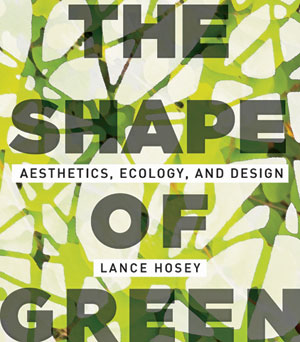Did you know that a clean neighborhood experiences one-fifth less crime than an untidy one, that profit margins for businesses near Rem Koolhaas's Seattle Public Library have risen 50 percent since it opened in 2004, that birdsong stimulates carbon sequestration by trees? Lance Hosey is on a mission to prove that society places value on beautiful environments, which makes them more enduring. His new book, The Shape of Green, leaves no case unturned for recognizing beauty as a valid consideration in green building.

Environmentalists have sounded the call for more beauty in design since at least 1994, when John Elkington conceived the term “triple bottom line” to argue that social equity and economic development endear a building to a community, thereby factoring into its sustainability as much as ecological footprint. The Shape of Green explains this three-pronged worldview, as well as other necessary backstories, such as the concept of embodied energy, without sounding at all like a textbook. Then, with equal flair, Hosey draws links between beauty and ecological responsibility, again and again.
Beauty's ability to prolong a design's relevance is gospel at Nokia, for example, which estimated that “prolonging the life expectancy of a phone by a year could cut [the phone's] total energy consumption by more than 40 percent.” Moving beyond statistics, Hosey says, “To reduce green building to a hollow list of material qualities robs architecture of its own kind of 'motive power.' ” However it makes its points, The Shape of Green claims that much green architecture has failed to connect emotionally with the public, and that these unbeautiful buildings are less sustainable than they seem.
The argument is style-agnostic. Just as he celebrates Koolhaas's futuristic library in Seattle as a revenue magnet, Hosey marvels at a classical column as anthropomorphic, relatable, and not easy to discard. Sidestepping the question of Modernism versus Classicism, he imagines an architecture in which beauty derives directly from sustainable performance.
Hosey distills his design philosophy to three guiding principles: conservation of materials and systems; attractiveness informed by principles found in nature; and connection to locality. Like Elkington's triple bottom line, these underlying concepts are not unprecedented. Biophilia—the study of humans' bond to nature—identifies many of the principles that Hosey defines as attractive. Urbanists and placemakers advocate the need for walkable cities with their own regionally distinct identities. And many consumers seem ready to buy such contemporary innovations as the Mission One electric motorcycle, which, in addition to eliminating the fuel pump, allows the rider to tuck his legs into the void where a gas engine would have been—thereby producing less wind resistance and even greater energy efficiency. What is new about The Shape of Green is Hosey's synthesis of research and design innovations that have been overlooked in many other books. He has crafted a sophisticated rallying cry and assembled a nascent toolbox for the next generation of eco-architects.


Post a comment to this article
Report Abusive Comment